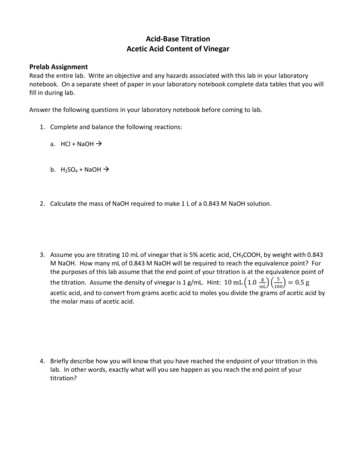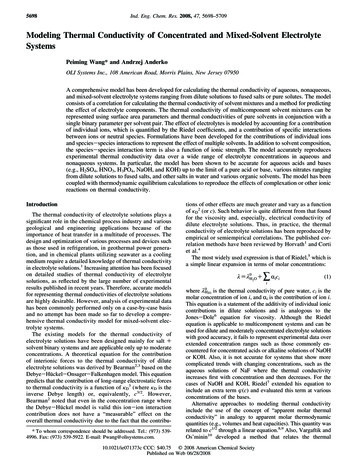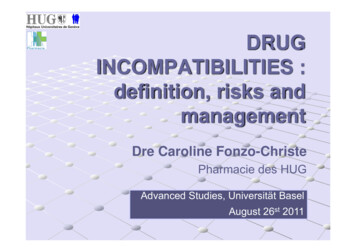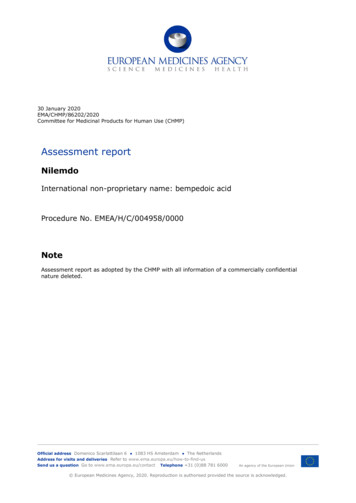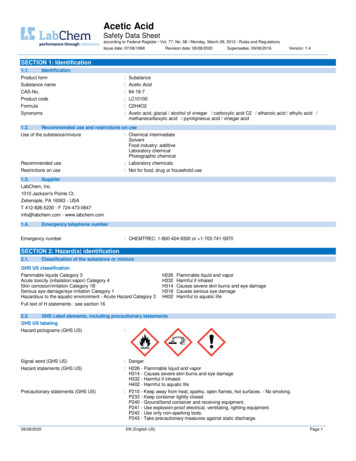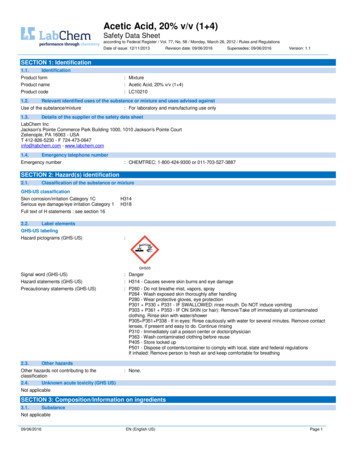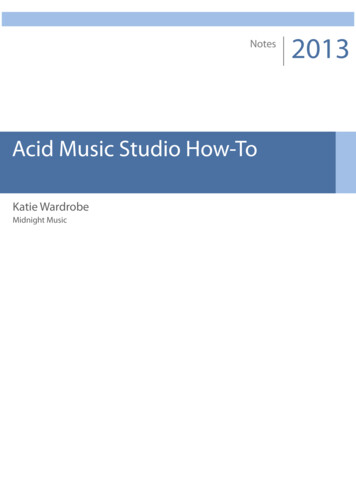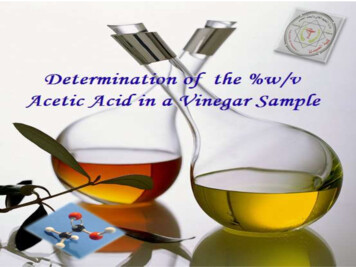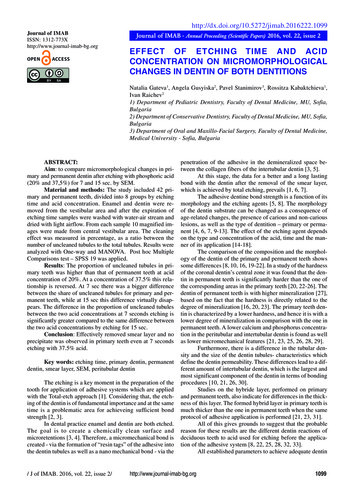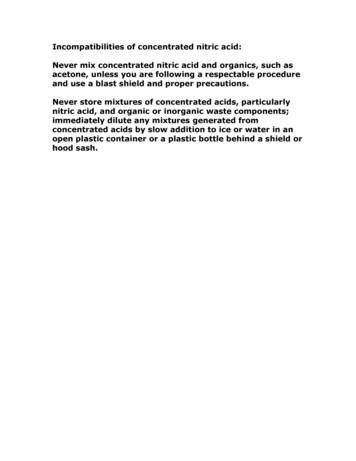
Transcription
Incompatibilities of concentrated nitric acid:Never mix concentrated nitric acid and organics, such asacetone, unless you are following a respectable procedureand use a blast shield and proper precautions.Never store mixtures of concentrated acids, particularlynitric acid, and organic or inorganic waste components;immediately dilute any mixtures generated fromconcentrated acids by slow addition to ice or water in anopen plastic container or a plastic bottle behind a shield orhood sash.
Chemical Compatibility Chart1 Inorganic Acids12 Organic acidsX23 CausticsXX4 Amines & AlkanolaminesXX5 Halogenated CompoundsX6 Alcohols, Glycols & Glycol EthersX7 AldehydesX8 KetoneX34XX56XXXXXX7X89 Saturated Hydrocarbons910 Aromatic HydrocarbonsX11 OlefinsX10X1112 Petrolum Oils1213 EstersXXX14 Monomers & Polymerizable EstersXXXX16 Alkylene OxidesXXXXXX17 CyanohydrinsXXXX18 NitrilesXXXX19 AmmoniaXX15 Phenols20 HalogensX21 EthersX22 Phosphorus, ElementalX13XXXX14XX15XXXXX Represents Unsafe CombinationsRepresents Safe CombinationsXXXXXXXXXXXXXXXXX18X19XXXX20XXXXX17X23 Sulfur, Molten24 Acid Anhydrides16XXXXXXXXX2122XXXX2324
Group 1: Inorganic AcidsChlorosulfonic acidHydrochloric acid (aqueous)Hydrofluoric acid (aqueous)Hydroge n chloride (anhydrous)Hydrogen fluoride (anhydrous)Nitric acidOleumPhosphoric acidSulfuric acidGroup 2: Organic AcidsAcetic acidButyric acid (n-)Formic acidPropionic acidRosin OilTall oilGroup 3: CausticsCaustic potash solutionCaustic soda solutionGroup 4: Amines and hylenetetramineTrimethylamineGroup 5: Halogenated CompoundsAllyl chlorideCarbon , crudeDichlorobenzene (o-)Dichlorobenzene (p-)DichlorodifluoromethaneDichloroethyl etherDichloropropaneDichloropropeneEthyl chlorideEthylene dibromideEthylene dichlorideMethyl bromideMethyl chlorideMethylene Propylene aneTrichloroethyleneTrichlorofluoromethaneGroup 6: Alcohols, Glycols and Glycol EthersAllyl alcoholAmyl alcohol1,4-ButanediolButyl alcohol (iso, n, sec, tert)Butylene glycolCorn syrupCyclohexyl alcoholDecyl alcohol (n, iso)Dextrose solutionDiacetone alcoholDiethylene glycolDiethylene glycol dimethyl etherDiethylene glycol monobutyl etherDiethylene glycol monoethyl etherDiethylene glycol monomethyl etherDiisobutyl carbitolDipropylene glycolDodecanolEthoxylated dodecanolEthoxylated pentadecanolEthoxylated tetradecanolEthoxylated tridecanolEthoxytriglycolEthyl alcoholEthyl butanol2-Ethylbuytl alcohol2-Ethylhexyl alcoholEthylene glycolEthylene glycol monobutyl etherEthylene glycol monoethyl etherEthylene glycol monomethyl etherFurfuryl alcoholGlycerineHeptanolHexanol
Group 6: Alcohols, Glycols and Glycol Ethers(cont.)Hexylene glycolIsoamyl alcoholIsooctyl alcoholMethyoxytriglycolMethyl alcoholMethylamyl alcoholMolasses, allNonanolOctanolPentadecanolPolypropylene glycol methyl etherPropyl alcohols (n, iso)Propylene glycolSorbitolTetradecanolTetraethylene glycolTridecyl alcoholTriethylene glycolUndecanolGroup 7: AldehydesAcetaldehydeAcrolein (inhibited)Butyraldehyde (n, iso)CrotonaldehydeDecaldehyde (n, iso)2-Ethyl-3-proplyacroleinFormaldehyde solutionsFurfuralHexamethylenetetramineIsooctyl aldehydeMethyl butyraldehydeMethyl formalParaformaldehydeValeraldehydeGroup 8: KetonesAcetoneAcetophenoneCamphor oilCylcohexanoneDiisobutyl ketoneIsophoroneMesityl oxideMethyl ethyl ketoneMethyl isobutyl ketoneGroup 9: Saturated obutaneLiquified natural gasLiquified petroleum eum ethersPetroleum naphthaPolybutenePropanePropylene butylene polymerGroup 10: Aromatic HydrocarbonsBenzeneCumenep-CymeneCoal tar oilDiethybenzeneDodecyl benzeneDowthermEthylbenzeneNaphtha, coal tarNaphthalene (includes molten)TetrahdyronaphthaleneTolueneTriethyl benzeneXylene (m-, o-, p-)Group 11: eneDipenteneDodecene1-DodeceneEthyleneLiquified petroleum tenePolybutenePropylenePropylene butylene polymer
Group 11: Olefins (cont.)Propylene tetramer ceneGroup 12: Petroleum OilsAsphaltGasolinesCasingeadAutomotiveAviationJet FuelsJP-1 (kerosene)JP-3JP-4JP-5 (kerosene, heavy)KeroseneMineral spiritsNaphtha (non aromatic)NaphthaSolventStoddard solventVM&POilsAbsorption oilClarified oilCrude oilDiesel oilFuel oilNo. 1 (kerosene)No. 1-DNo. 2No. 2-DNo. 4No. 5No. 6Lubricating oilMineral oilMineral seal oilMotor oilPenetration oilRange oilRoad oilSpindle oilSpray oilTransformer oilTurbine oilGroup 13: EstersAmyl acetateAmyl tallateButyl acetates (n, iso, sec)Butyl benzyl phthalateCastor oilCroton oilDibutyl phthalateDiethyl carbonateDimethyl sulfateDioctyl adipateDioctyl phthalateEpoxidized vegetable oilsEthyl acetateEthyl diacetateEthylene glycol monoethyl ether acetateEthylhexyl tallateFish oilGlycol diacetateMethyl acetateMethyl amyl acetateNeatsfoot oilOlive oilPeanut oilPropyl acetates (n, iso)Resin oilSoya bean oilSperm oilTallowTanner’s oilVegetable oilWax, carnaubaGroup 14: Monomers and PolymerizableestersAcrylic acid (inhibited)AcrylonitrileButadiene (inhibited)Butyl acrylate (n, iso)Ethyl acrylate (inhibited)2-Ethylhexyl acrylate (inhibited)Isodecyl acrylate (inhibited)Isoprene (inhibited)Methyl acrylate (inhibited)Methyl methacrylate (inhibited)o-PropiolactoneStyrene (inhibited)Vinyl acetate (inhibited)Vinyl chloride (inhibited)Vinylidene chloride (inhibited)Vinyl toluene
Group 15: PhenolsCarbolic oilCreosote, coal tarCresolsNonylphenolPhenolGroup 16: Alkylene OxidesEthylene OxidePropylene OxideGroup 17: CyanohydrinsAcetone cyanohydrinEthylene cyanohydrinGroup 18: NitrilesAcetonitrileAdiponitrileGroup 19: AmmoniaAmmonium hydroxideGroup 20: HalogensBromineChlorineGroup 21: EthersDiethyl ether (ethyl ether)1, 4, DioxaneIsoprophyl etherEthers (cont)TetrahydrofuranGroup 22: Phosphorus, elementalGroup 23: Sulfur, moltenGroup 24: Acid AnhydrideAcetic anhydridePropionic anhydride
Mallinckrodt Specialty Chemicals Co. – Chemical Compatibility ListThe following provides some chemicals which are incompatible with other compounds.Avoid contacting, in storage and in working, as explosion or toxic fume or other hazardmay result. (SOURCE: Mallinckrodt Specialty Chemicals Co. 5/89)Incompatible SubstancesCOMPOUND(S)Acetic acidINCOMPATIBLE WITH:chromic acid, nitric acid, ethylene glycol, perchloric acid,peroxides and permanganatesAcetoneconcentrated sulfuric and nitric acid mixturesAcetylenecopper tubing, fluorine, bromine, chlorine, iodine, silver, mercuryAmmonia anhydrous mercury, halogens, calcium hypochlorite, hydrogen fluoride (HF)Ammonium Nitrate acids, metal powders, flammable liquids, chlorates, nitrates, sulfur,finely divided organics or combustiblesAnilinenitric acid, hydrogen peroxideArsenic compounds any reducing agentAzidesacidsBromineammonia, acetylene, butadiene, butane, hydrogen, sodium carbide,turpentine, finely divided metalsCalciumwater, carbon dioxide, carbon tetrachloride, and chlorinatedhydrocarbonsCarbon, activatedcalcium hypochlorate, all oxidizing agentsChloratesammonium salts, acids, metal powders, sulfur, finely dividedorganics or combustibles, carbonChromic acidacetic acid, naphthalene, camphor, alcohol, glycerine, turpentine,alkalis, other flammable liquidsChlorine Dioxideammonia, methane, phosphine, hydrogen sulfideChlorineammonia, acetylene, butadiene, benzene, petroleum fractions,hydrogen, sodium carbide, turpentine, and finely divided metalpowdersCopperacetylene, hydrogen peroxideCyanidesacids and alkalis (bases)Flammable Liquids ammonium nitrate, chromic acid, hydrogen peroxide, nitric acid,sodium peroxide, halogensFluorineisolate from everythingHydrazinehydrogen peroxide, nitric acid, all oxidizersHydrocarbonsfluorine, chlorine, bromine, chromic acid, peroxideHydrocyanic acidnitric acid, alkalisHydrofluoric acidammonia, alkalisHydrogen Sulfidefuming nitric acid, oxidizing gasesHypochloritesacids, activated carbonsIodineacetylene, ammonia, hydrogenMercurysulfuric acid
Nitric acid (conc)acetic acid, aniline, chromic acid, hydrocyanic acid, hydrogensulfide, flammable liquids, flammable gases, copper, brass, heavymetalsNitritesacidNitroparrafinsinorganic bases, aminesOxalic acidssilver, mercuryOxygenoils, grease, hydrogen, flammable liquids, solids or gasesPerchloric Acidacetic anhydride, bismuth, alcohol, paper, wood, oil and greasePeroxides, organicacids, friction, heat, sparksPhosphorous, white air, oxygen, alkalis, reducing agentsPhosphorous pentoxidewaterPotassiumcarbon tetrachloride, carbon dioxide, waterPotassium chlorate sulfuric and other acidsPotassium perchlorate sulfuric and other acids (see Chlorates also)Potassium permanganate glycerol, ethylene glycol, benzaldehyde, sulfuric acidSelenidesreducing agentsSilveracetylene, oxalic acid, tartaric acid, ammonium compounds,fulminic acidSodiumcarbon tetrachloride, carbon dioxide, waterSodium nitriteammonium nitrate and other ammonium saltsSodium peroxideethyl or methyl alcohol, glacial acetic acid, acetic anhydride,benzaldehyde, carbon disulfide, glycerin, ethylene glycol, ethyl ormethyl acetate, furfuralSulfidesacidsSulfuric Acidpotassium (sodium or lithium) chlorate, perchlorate, orpermanganateTelluridesreducing agents
EPA's Chemical Compatibility ChartEPA-600/2-80-076 April 1980A METHOD FOR DETERMINING THE COMPATIBILITY OF CHEMICAL MIXTURESPlease Note: This chart is intended as an indication of some of the hazards that can be expected on mixing chemical wastes. Becauseof the differing activities of the thousands of compounds that may be encountered, it is not possible to make any chart definitive and allinclusive. It cannot be assumed to ensure compatibility of wastes because wastes are not classified as hazardous on the chart, nor do anyblanks necessarily mean that the mixture cannot result in a hazard occurring. Detailed instructions as to hazards involved in handlingand disposing of any given waste should be obtained from the originator of the waste.#REACTIVITY GROUP NAME1Acids, Mineral, Non-oxidizing2Acids, Mineral, Oxidizing3Acids, Organic4Alcohols and Glycols5AldehydesHHP6AmidesH78Amines, Aliphatic and AromaticAzo Compounds, DiazoCompounds and des, InorganicGT16Hydrocarbons, Aromatic17Halogenated PHP456HHGHHGHGTGFH,GTGFGT21KetonesHMercaptans and Other Organic GTSulfidesGFMetals, Alkali and Alkaline Earth, H,FElementalGFGTHFH,FGTH,FGTHFH,FGTH,FGF22Metals, Other Elemental & Alloys H,Fas Powders, Vapors, or Sponges GFH,FGFGFMetals, Other Elemental & Alloys H,Fas Sheets, Rods, Drops, etc.GFMetals and Metal 32425262728293031Nitro Compounds, OrganicHydrocarbons, Aliphatic,UnsaturatedHydrocarbons, Aliphatic,SaturatedPeroxides and Hydroperoxides,Organic32Phenols and hioates33Sulfides, Inorganic34101EpoxidesCombustible and FlammableMaterials, Miscellaneous102Explosives103Polymerizable Compounds104Oxidizing Agents, Strong105106Reducing Agents, StrongWater and Mixtures ContainingWater107Water Reactive GFHFHF9HGHGFGT10GHGHGUFFireGInnocuous and non-flammable gas generationGTToxic Gas formationGFFlammable Gas formationE7CONSEQUENCEHeat GenerationExplosionPViolent PolymerizationSSolubilization of toxic substanceUMay be hazardous, but H,P H,FGFEGTGFDO NOT MIX WITH ANY CHEMICAL OR WASTE MATERIAL!14HEHE31UHGTHPH,FGTHEPHHGHEHG2HGFHHF ---EXTREMELY REACTIVE!1HHE26105GFGT106105106EXTREMELY REACTIVE!--- 2728293031323334101102103104107107
Acetic acid Butyric acid (n-) Formic acid Propionic acid Rosin Oil Tall oil Group 3: Caustics Caustic potash solution Caustic soda solution Group 4: Amines and Alkanolamines Aminoethylethanolamine Aniline Diethanolamine Diethylenetriamine Diisopropanolamine Dimethylamine Ethylenediamine Hexamethylenediamine 2-Methyl-5-ethylpyridine Monoethanolamine Monoisopropanolamine
